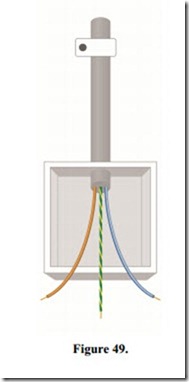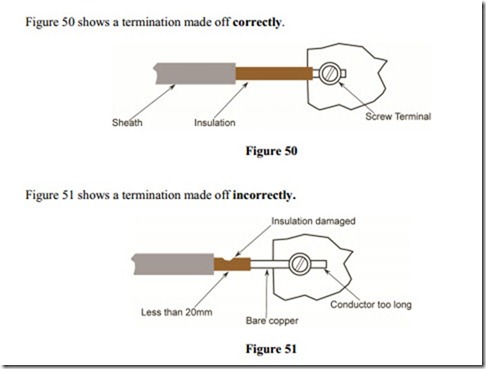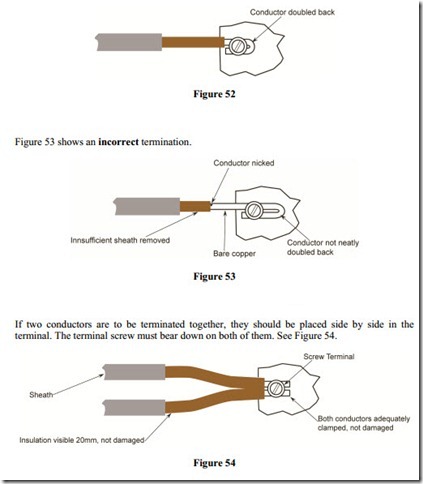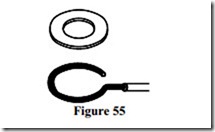Cable Mechanical Protection
The PVC sheath must enter into any enclosure to protect the conductor insulation from damage. Once inside the enclosure, the sheath can be removed because the enclosure now provides mechanical protection for the cable insulation.
There should be sufficient cable slack allowed in an enclosure to facilitate the termination and remaking of cables. This will also facilitate any alterations to the circuit or replacement of accessories. See Figure 49.
Terminating Techniques
Screw Terminal
There are a variety of methods used to terminate conductors. One of the most common types is the screw terminal. Regardless of the type of terminal used it is important that the joint between the conductor and the terminal is electrically and mechanically sound, without putting undue pressure on the conductor or the terminal. In other words the terminal screw should be sufficiently tight. The conductor insulation should be removed far enough to allow the conductor enter the terminal. The conductor should be insulated right up to the metal of the terminal. Stranded conductors should be twisted to form a solid mass. The cable sheath should be removed a distance of at least 20 mm. This must be done to prevent surface leakage current, allow more flexibility at the termination and also to identify the core colour.
If the conductor is small in relation to the terminal, the conductor must be doubled back fully, neatly on itself. See Figure 52 for a correct termination.
Screw Head and Nut and Washer Terminals
When terminating conductors under screw-heads or nuts, it is best to form the conductor into an eye, using round nose pliers. The eye should be slightly larger than the screw diameter, but smaller than the outside diameter of the screwhead, nut or washer.
The eye should be placed in such a way that rotation of the screw head or nut tends to close the joint in the eye. If the eye is put the opposite way round, the motion of the screw or nut will tend to untwist the eye, and will probably result in poor contact. The conductor should be wound at least three quarter way round the screw. See Figure 55.
Clamp Type Terminal
These terminals are used in a similar manner to the screw type terminal. They provide heavier clamping, generally for terminating larger conductors. The clamping plate may be ribbed in order to put small indents into the conductor to provide better electrical and mechanical contact.
Related posts:
Incoming search terms:
- mechanical protection of service wire residential
- What is meant by electrical sound and mechanically sound joints
- why a joint in a conduit must be mechanically and electrically sound
- electrically sound meaning
- why should cable joints be mechanically sound
- what is mechanical protection for cables
- mechanical protection of cable
- mechanical protection electrical cables
- electrically sound joint
- Why should a joint be mechanically and electrically sound
- what electrically sound joint
- what are electrically sound joints
- what is electrically and mechanically sound
- What Is A Mechanical Sound Joint
- what is electrically sound joint and mechanically sound joint
- what is meant by a mechanically sound joint
- what is electrically sound
- what is meant by an electrically sound joint?
- what is meant by an mechanically sound joint?
- why should be a cable joint be mechnically and electrically sound
- why should a joint of a cable be mechaincally and electrically sound
- why should a joint be electrically and mechanically sound
- why should a electrical joint be mechanically sound
- why electrical joints should be electrically sound
- why cable joints must be mechanically and electrical sound
- whats mechanically sound inregulation of a conductor
- What meaning mechanical sound of electrical Joint
- what is meant by electrically sound and mechanically sound in joints
- what does mechanically sound electrically sound mean
- what does electrically and mechanically sound means
- maechanical protection as a part of cable
- joint must be electrical and mechanical sound why?
- Explain what is electrically sound
- Explain the mechanical protection of the conductor
- Explain the importance of insulator and mechanical protection in a cable
- explain termination using a cable
- explain mechanically electrically sound joint
- dominarstrate soundness of the join electrucalt
- difference electrically sound joint and mechanically sound joints
- Meaning of a joint mechanically and electrically sound
- meaning of cable joint in mechanically sound and electrically sound
- state the purpose of mechanical protection for cables
- requirements for electrically sound joints
- mechnical sound of cable joint
- mechanically sound joint
- Mechanical protection for outgoing cable
- mechanical protection for electrical cables
- mechainicaly sound definition in electric joints
- meaning of electrically and mechanically sound in joints
- meaning of electrically and mechanically sound



